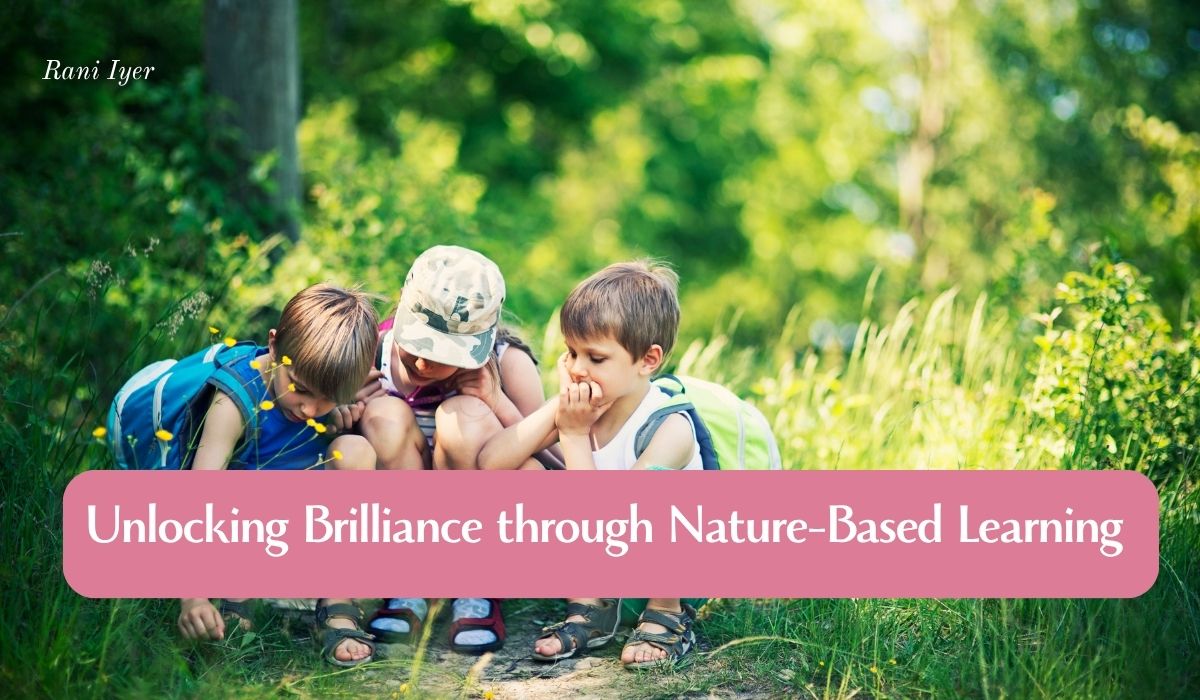Imagine a world where children’s laughter mingles with the rustle of leaves and the chirping of birds, igniting a spark of curiosity that fuels their cognitive growth. In our increasingly screen-driven society, nature-based learning emerges as a powerful antidote, offering not just a break from technology but a treasure trove of developmental opportunities. Engaging with the natural world enhances critical thinking, fosters creativity, and strengthens emotional resilience. As children explore diverse environments, they cultivate not only vital skills but also a deep-rooted appreciation for the world around them. This article delves into the profound ways that nature-based learning unlocks brilliance in young minds, revealing how outdoor play and exploration lay the groundwork for lifelong learning. Join us on this journey to discover how the sights, sounds, and experiences of nature can profoundly shape cognitive development, setting the stage for a brighter, more inquisitive future.
The Science Behind Cognitive Development in Children
Cognitive development in children is an intricate process involving the growth of brain functions such as memory, problem-solving, and decision-making. This development is influenced by a combination of genetic factors and environmental experiences. As children interact with their surroundings, they form neural connections that lay the foundation for cognitive abilities. Research indicates that early childhood is a critical period for brain development, where experiences can significantly shape future cognitive functions. The brain’s plasticity during these years means that enriching environments can have lasting positive impacts on a child’s intellectual growth.
Environmental stimuli play a crucial role in cognitive development. For instance, activities that stimulate the senses—such as touching different textures, smelling various scents, and listening to diverse sounds—enhance neural connections. These sensory experiences are vital for the development of perception, attention, and memory. Moreover, social interactions, whether with peers or adults, contribute to language acquisition and the understanding of social norms and behaviors. Thus, a stimulating environment that encompasses a variety of sensory and social experiences is essential for optimal cognitive growth.
Recent studies have highlighted the importance of nature in cognitive development. Exposure to natural environments has been shown to improve attention span, enhance problem-solving skills, and boost creativity. Nature-based learning, which involves outdoor activities and exploration, provides a rich, multisensory experience that is often lacking in traditional classroom settings. By engaging with nature, children can develop a deeper understanding of the world, improve their cognitive skills, and foster a love for learning that can last a lifetime.
Benefits of Nature-Based Learning
Nature-based learning offers a myriad of benefits that extend beyond cognitive development. One of the most significant advantages is the enhancement of physical health. Outdoor activities encourage children to be active, improving their physical fitness, coordination, and motor skills. These activities also expose children to fresh air and sunlight, which are essential for overall well-being. Furthermore, spending time in nature has been linked to reduced stress levels and improved mental health, contributing to a sense of calm and well-being.
In addition to physical health benefits, nature-based learning fosters social and emotional development. Outdoor environments provide opportunities for cooperative play, teamwork, and the development of social skills. Children learn to communicate, negotiate, and resolve conflicts as they engage in group activities. Nature also offers a sense of wonder and discovery, which can boost self-esteem and confidence. The freedom to explore and take risks in a safe environment helps children develop resilience and adaptability.
Cognitively, nature-based learning enhances critical thinking and problem-solving skills. The unpredictable and dynamic nature of outdoor environments requires children to think on their feet and adapt to new situations. These experiences encourage curiosity and creativity, as children are constantly discovering new things and finding innovative solutions to challenges. Additionally, nature-based learning promotes a deeper understanding of scientific concepts, as children observe and interact with natural phenomena firsthand.
Key Elements of Nature-Based Learning Programs
Effective nature-based learning programs incorporate several key elements that ensure a comprehensive and enriching experience for children. One of the essential components is diverse and engaging outdoor environments. These environments should include a variety of natural features such as trees, rocks, water bodies, and open spaces, which provide opportunities for exploration and discovery. The diversity of landscapes allows children to engage in different types of play and learning experiences, from climbing and running to observing wildlife and studying plant life.
Another crucial element is a child-centered approach that emphasizes hands-on, experiential learning. Nature-based programs should encourage children to take the lead in their learning, allowing them to follow their interests and curiosities. This approach fosters a sense of ownership and intrinsic motivation, making learning more meaningful and enjoyable. Educators and facilitators play a supportive role, guiding and scaffolding children’s experiences without dictating or controlling their activities.
Integration of interdisciplinary learning is also vital in nature-based programs. Outdoor environments offer rich opportunities to connect various subjects such as science, mathematics, literature, and art. For example, children can learn about ecosystems and biodiversity through direct observation, apply mathematical concepts by measuring natural objects, and express their creativity through nature-inspired art projects. This holistic approach not only enhances cognitive skills but also helps children see the interconnectedness of knowledge and the relevance of their learning to the real world.
Case Studies: Successful Nature-Based Learning Initiatives
Several successful nature-based learning initiatives around the world serve as inspiring examples of how outdoor education can transform children’s cognitive development. One notable case is the Forest School movement, which originated in Scandinavia and has since spread to many countries. Forest Schools provide regular, long-term access to natural environments, where children engage in activities such as building shelters, cooking over campfires, and exploring wildlife. Research on Forest Schools has shown significant improvements in children’s confidence, social skills, and academic performance.
Another successful initiative is the Nature Kindergarten model in Canada. These programs immerse children in outdoor environments for the majority of their school day, regardless of weather conditions. Children participate in various activities, from planting and harvesting in gardens to tracking animal footprints in the snow. Studies have found that children in Nature Kindergartens exhibit better attention spans, higher levels of creativity, and greater environmental stewardship compared to their peers in traditional settings.
In the United States, the Outdoor Classroom Project is a prominent example of integrating nature-based learning into early childhood education. This initiative supports preschools and childcare centers in creating outdoor learning environments that foster exploration and discovery. Programs under the Outdoor Classroom Project emphasize natural play spaces, gardening, and environmental education. Evaluations of these programs have reported positive outcomes in children’s cognitive, social, and emotional development, as well as increased engagement and enthusiasm for learning.
How Nature Exposure Enhances Creativity and Problem-Solving
Nature exposure has a profound impact on enhancing creativity and problem-solving skills in children. The unstructured and ever-changing environments found in nature provide endless opportunities for imaginative play and creative thinking. Unlike traditional playgrounds or indoor settings, natural spaces offer a blank canvas where children can invent their own games, build structures from natural materials, and create stories inspired by their surroundings. This freedom to explore and experiment nurtures creativity and encourages divergent thinking.
Problem-solving skills are also sharpened through nature-based learning. The unpredictable nature of outdoor environments requires children to navigate challenges and find solutions independently. For example, building a fort from branches and leaves involves planning, testing, and adjusting their designs. Similarly, observing and understanding natural phenomena, such as the behavior of animals or the growth of plants, cultivates critical thinking and scientific inquiry. These experiences teach children to approach problems with an open mind, consider multiple perspectives, and persist in finding solutions.
Moreover, nature exposure promotes a sense of curiosity and a love for learning. The natural world is full of wonders and mysteries that capture children’s attention and spark their interest. Whether it’s the intricate patterns on a butterfly’s wings or the complex structure of a spider’s web, nature inspires awe and curiosity. This intrinsic motivation to explore and understand the world around them lays the foundation for lifelong learning and intellectual growth.
Integrating Nature-Based Learning into Early Childhood Education
Integrating nature-based learning into early childhood education requires a thoughtful and intentional approach. One of the first steps is to create outdoor learning environments that are safe, accessible, and engaging for young children. Schools and childcare centers can develop natural play areas with elements such as sand, water, logs, and plants. These spaces should encourage exploration, sensory experiences, and physical activity. Additionally, incorporating features like gardens, bird feeders, and insect hotels can provide opportunities for hands-on learning and environmental stewardship.
Teacher training and professional development are crucial for the successful implementation of nature-based learning. Educators need to be equipped with the knowledge and skills to facilitate outdoor learning experiences effectively. This includes understanding child development, recognizing the educational potential of natural environments, and developing strategies for guiding and supporting children’s exploration. Professional development programs can offer workshops, resources, and mentorship to help teachers integrate nature-based learning into their curriculum and teaching practices.
Curriculum design should also reflect the principles of nature-based learning. This involves incorporating outdoor activities and nature-related themes into various subjects. For example, literacy lessons can include nature-themed stories and writing prompts, while science lessons can involve observing and documenting weather patterns or plant growth. Interdisciplinary projects that connect different areas of learning can provide meaningful and engaging experiences for children. Furthermore, flexibility in scheduling and lesson planning allows for spontaneous outdoor exploration and capitalizes on teachable moments in nature.
Overcoming Challenges in Implementing Nature-Based Learning
Despite the numerous benefits of nature-based learning, there are challenges to its implementation that need to be addressed. One common obstacle is the lack of access to natural spaces, particularly in urban areas. Schools and childcare centers may have limited outdoor space or be located far from parks and natural reserves. To overcome this, educators can create natural play areas within school grounds using plants, rocks, and other natural materials. Collaborating with local parks and community organizations can also provide opportunities for field trips and outdoor learning experiences.
Another challenge is the perception that outdoor learning is less academic or rigorous compared to traditional classroom instruction. Some parents and educators may be concerned that time spent outdoors detracts from core academic subjects. However, research and case studies demonstrate that nature-based learning enhances academic performance and cognitive development. Educators can address these concerns by showcasing the educational value of outdoor experiences and aligning nature-based activities with curriculum standards and learning objectives.
Weather conditions and safety concerns can also pose challenges to nature-based learning. Inclement weather may limit outdoor activities, and there may be worries about injuries or exposure to environmental hazards. To mitigate these issues, schools can adopt a flexible approach, allowing for a mix of indoor and outdoor activities based on weather conditions. Providing appropriate clothing and gear for different weather scenarios ensures that children can participate comfortably and safely. Additionally, implementing safety guidelines and conducting risk assessments help create a secure environment for outdoor learning.
Resources for Parents and Educators
There are numerous resources available to support parents and educators in implementing nature-based learning. Organizations such as the Children & Nature Network and the National Wildlife Federation offer a wealth of information, including research articles, activity guides, and toolkits. These resources provide practical tips and strategies for integrating outdoor learning into everyday routines and educational programs. Additionally, online communities and forums offer opportunities for sharing experiences, seeking advice, and connecting with like-minded individuals.
Books and publications on nature-based learning also serve as valuable resources. Titles such as “Last Child in the Woods” by Richard Louv and “The Nature Principle” by the same author explore the importance of nature in child development and provide insights into creating nature-rich environments. “Balanced and Barefoot” by Angela Hanscom offers practical advice for promoting outdoor play and physical activity. These books can inspire and guide parents and educators in fostering a deeper connection with nature for children.
Professional development programs and workshops are essential for educators to enhance their knowledge and skills in nature-based learning. Many organizations and institutions offer training sessions, certifications, and continuing education courses focused on outdoor education. These programs cover topics such as curriculum design, risk management, and the benefits of nature-based learning. Attending conferences and seminars also provides opportunities for networking and learning from experts in the field. By investing in professional development, educators can effectively implement and sustain nature-based learning initiatives.
Ecolabs founded by Dr. Rani Iyer is developing many resources for fostering nature-based learning in young people. Sign up for the newsletter to learn more.
Conclusion: The Future of Nature-Based Learning in Child Development
As we look to the future, it is clear that nature-based learning has the potential to play a transformative role in child development. The growing body of research and successful case studies highlight the profound impact that outdoor experiences can have on cognitive, social, and emotional growth. By fostering a deep connection with the natural world, nature-based learning not only enhances academic performance but also cultivates a lifelong love for learning and environmental stewardship.
To fully realize the benefits of nature-based learning, it is essential to address the challenges and barriers to its implementation. This includes creating accessible and engaging outdoor environments, providing professional development for educators, and advocating for the integration of nature-based learning into educational policies and practices. Collaboration between schools, communities, and organizations can help build a supportive infrastructure that promotes outdoor learning for all children.
Ultimately, the future of nature-based learning lies in our collective commitment to prioritizing and valuing the role of nature in education. By embracing the wonders of the natural world and recognizing its importance in child development, we can unlock the brilliance in every child and set the stage for a brighter, more inquisitive future. As children laugh, explore, and learn amidst the rustle of leaves and the chirping of birds, we can be confident that we are nurturing their cognitive growth and preparing them for a lifetime of curiosity and discovery.


